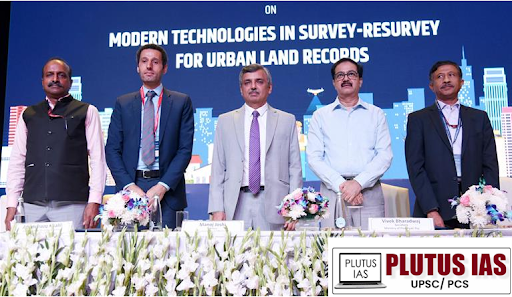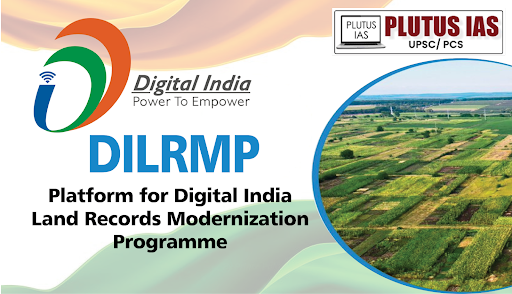24 Oct “Modernizing Land Records for a New India: The DILRMP Initiative”
This article covers “Daily Current Affairs” and topic details of the Digital India Land Records Modernization Programme (DILRMP)
Syllabus mapping:
GS-3: Agriculture: Technology in farmers aid and Land reforms.
For Prelims:
What is DILRMP and what are key objectives, achievements, nodal ministry, and innovative initiatives under the DILRMP?
For Mains:
What is the significance of the scheme to reduce the land dispute, issues in its implementation, and ways forward to make the scheme effective?
Why in the News?
Union Minister of Rural Development Shri Shivraj Singh Chouhan inaugurated an International Workshop on Modern Technologies in Survey-Resurvey for Urban Land Records, recently organized by the Department of Land Resources.

The Digital India Land Records Modernization Programme (DILRMP)
DILRMP:
The Digital India Land Records Modernization Programme (DILRMP), formerly known as the National Land Record Modernization Programme, was revamped into a Central Sector Scheme effective April 1, 2016, with 100% funding from the Centre. Its objective is to create a modern, comprehensive, and transparent land record management system. The DILRMP is implemented by the Ministry of Rural Development, Government of India.
Key Objectives:
Real-time Land Information: Improve access to accurate and timely data.
Resource Optimization: Enhance the utilization of land resources.
Support for Stakeholders: Benefit landowners and prospective buyers.
Policy Assistance: Aid in effective planning and policy-making.
Dispute Reduction: Minimize land-related conflicts.
Fraud Prevention: Curb fraudulent and benami transactions.
Digital Access: Reduce the necessity for physical visits to Revenue and Registration offices.
Information Sharing: Facilitate collaboration with various organizations and agencies.
Key Achievements
Computerization of Land Records: 95.08% of Record of Rights (RoR) completed across 625,062 villages out of 657,396.
Digitization of Cadastral Maps: 68.02% completed, with 24,957,221 maps digitized out of 36,692,728.
Computerization of Registration: 94.95% completed in 5,060 out of 5,329 Sub-Registrar Offices (SROs).
Integration of SROs with Land Records: 87.48% integration completed (4,662 out of 5,329 SROs).
Five-year extension for the DILRMP (2021-22 to 2025-26): Consent-based integration of Aadhaar with land records. Computerization of Revenue Courts and their integration with land records.
Innovative Initiatives
Unique Land Parcel Identification Number (ULPIN) or Bhu-Aadhar
A 14-digit unique ID based on geo-coordinates for each land parcel.
Facilitates real estate transactions and helps resolve boundary issues.
Implemented in 29 States/UTs, with pilot testing ongoing in additional regions.
National Generic Document Registration System (NGDRS) or E-Registration
A uniform registration process for deeds and documents, streamlining registration through online services.
Adopted in 18 States/UTs, with data sharing implemented in 12 states.
Linkage of e-Court with Land Records/Registration Database
Provides authentic information to courts for speedy case disposal.
Integration approved in 26 States/UTs to enhance legal processes.
Transliteration of Land Records
Converts local language records into any of the 22 languages in Schedule VIII.
Pilot tests are underway in 8 States, with 17 States/UTs already using the tool.
Bhoomi Samman (Platinum Grading Certificate Scheme)
Targets saturation in basic components like record computerization and cadastral map digitization.
As of December 20, 2023, 168 districts in 16 States achieved Platinum Grading for completing over 99% of essential tasks.
Significance of Land Records
High Litigation: Accurate land records reduce disputes and litigations over land ownership, ensuring smoother legal processes.
Agricultural Credit: Land serves as collateral for farmers to obtain loans. Reliable land records are essential for securing agricultural credit and improving farmers’ access to financial resources.
Development of New Infrastructure: As India’s economy transitions from agrarian to manufacturing and services, comprehensive land records facilitate the development of infrastructure projects, ensuring efficient land utilization and planning.
Urbanization and Housing Shortage: Rapid urbanization has altered land use patterns, increasing the demand for accurate land records to address housing shortages and manage urban expansion effectively.
Benami Transactions: Reliable land records help curb Benami transactions, where properties are held under fictitious names. This transparency is vital in combating black money, as highlighted in the White Paper on Black Money (2012).
Women’s Land Titles: Proper land records are essential for ensuring women can secure land titles, promoting gender equality, and empowering women economically by providing them with ownership rights.
Proper Government Support: Accurate and updated land records enable the government to implement policies effectively, ensuring proper support for land reform initiatives, social justice, and sustainable development.
Challenges of the Digital India Land Records Modernization Programme (DILRMP)
Local Administration Issues: Local administrations struggle to maintain accurate land records and effectively implement DILRMP initiatives.
Fraud and Malpractices: The land registration and administration system is vulnerable to fraudulent activities and malpractices, undermining public trust.
Time Delays: The processing of land records and registration often experiences significant time delays, affecting efficiency and accessibility.
Human Error: Manual data entry and management increase the likelihood of human errors, leading to incorrect land records.
Inaccurate Land Records: Many land litigations arise from inaccuracies in land records, causing disputes and legal complications.
Lack of Awareness: There is a general lack of awareness among landowners and stakeholders about the DILRMP and its benefits, limiting public engagement and utilization.
Corruption During Record Entry: Corruption in the recording process leads to manipulated data entries, affecting the integrity of land records.
Lack of Data from Remote Areas: Remote regions often lack comprehensive data, making it difficult to implement uniform land record systems across the country.
Way Forward
Effective Implementation: Ensure rigorous adherence to proper recording practices for land ownership and transactions to maintain accuracy and reliability.
Faster Use of Digitalization: The Parliamentary Standing Committee suggests leveraging innovative technologies for rapid digitalization of land records, making the process more efficient and accessible.
Accurate Recording in Remote and Border Areas: Focus on improving land record accuracy in remote and border regions, where challenges in data collection and management persist.
Cooperation Among States: Foster collaboration between states and central agencies to facilitate comprehensive land record management and address discrepancies.
Adoption of the Torrens System: Implement the Torrens system for recording and registering land ownership, which offers guaranteed titles to property owners, thereby enhancing legal clarity and reducing disputes.
Reducing Registration Costs: Work on minimizing the costs associated with land property registration, making the process more accessible for landowners.
Proper Maintenance of Land Records and Spatial Data: Establish robust systems for the ongoing maintenance of land records and associated spatial data to ensure their accuracy and relevance over time.
Capacity Building: Invest in capacity-building initiatives to enhance the skills of personnel involved in data collection and storage at village, city, and block levels. This will strengthen land management practices and facilitate effective updating of records.
Conclusion
The digitization of land records is an urgent necessity, as land is integral to our culture and tradition. The Digital India Land Records Modernization Programme (DILRMP) serves as a significant step in this regard, but it is essential to implement it effectively. Recent experiences over the last few years indicate that the scheme is working in the right direction, yet it is crucial to address and remove existing glitches.
Download plutus ias current affairs (ENG) 24th Oct 2024
Prelims Question:
Q. With reference to the Consider the following statement:
1. The Digital India Land Records Modernization Programme (DILRMP) is launched during the eleventh Five-year plan.
2. The one of the objectives of DILRMP is to provide the Bhu-Aadhar to farmers
3. The Scheme is implemented by the state agriculture departments.
How many of the above-given statements are correct?
A. Only one
B. Only two
C. All three
D. None
ANSWER: A
Mains Question:
Evaluate the objectives of the Digital India Land Records Modernization Programme (DILRMP) in achieving land rights for women, reducing land-related disputes, and easy traceability of formal credits. ( Answer in 250 words)




No Comments